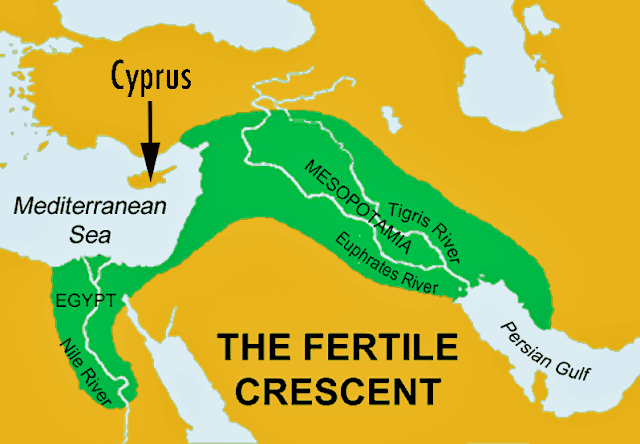 |
| Similarity in appearance is still evident after 10,000 years. Image: MikeB |
Below is a summary of the study from a report from the University of Missouri. The scientist, Leslie A. Lyons, a feline geneticist and Gilbreath-McLorn endowed professor of comparative medicine in the MU College of Veterinary Medicine, was the study leader and author.
Domestic cats are thought to have originated from the wildcat species, Felis silvestris, which still exists today. The domestication of cats is believed to have begun when humans settled in the Fertile Crescent, the region surrounding the Tigris and Euphrates rivers in the Middle East. Cats were attracted to the settlements because of the presence of rodents, which were a source of food for the cats.
 |
| Fertile Crescent location where wildcat domestication first occurred. Image: MikeB based on one in the public domain as assessed. |
The new study at the University of Missouri used DNA analysis to examine the genetic makeup of cats from the Fertile Crescent area and other parts of the world. The researchers found that the genetic makeup of the cats in the Fertile Crescent was similar to that of wildcats, suggesting that the domestication of cats likely began in this region. The researchers also found that as humans migrated to other parts of the world, they likely took their cats with them, resulting in the spread of domesticated cats to other parts of the world.
 |
| Another map of the Fertile Crescent. Image in public domain. |
Domestic cats, like many other domesticated animals, have evolved to live and thrive in close association with humans. However, unlike other domesticated animals such as dogs, the domestication of cats has not resulted in significant changes to their natural behaviors. Cats are known to be skilled hunters and are able to take care of themselves in the wild, making them "semi-domesticated" animals.
The study at the University of Missouri used genetic analysis to provide evidence for the theory that cats were first domesticated in the Fertile Crescent region of the Middle East and were later transported by humans to other parts of the world. The researchers found that the genetic makeup of cats in the Fertile Crescent was similar to that of wildcats, suggesting that the domestication of cats likely began in this region. As humans migrated to other parts of the world, they likely brought their cats with them, resulting in the spread of domesticated cats to other parts of the world.
The study at the University of Missouri used genetic analysis to provide evidence for the theory that cats were first domesticated in the Fertile Crescent region of the Middle East and were later transported by humans to other parts of the world. The researchers found that the genetic makeup of cats in the Fertile Crescent was similar to that of wildcats, suggesting that the domestication of cats likely began in this region. As humans migrated to other parts of the world, they likely brought their cats with them, resulting in the spread of domesticated cats to other parts of the world.



The map is misleading. The area shown as the fertile crescent is desert. More likely it is the green area. Some scientists claim that Cyprus is where cat domestication first took place since the oldest arqueological evidence of a human-cat relationship was uncovered there,
ReplyDeleteWell, all the maps of the Fertile Crescent are similar. I have published another. Perhaps part of it now is desert but at the time of the domestication of the wildcat is was fertile! 😃✔️
Delete